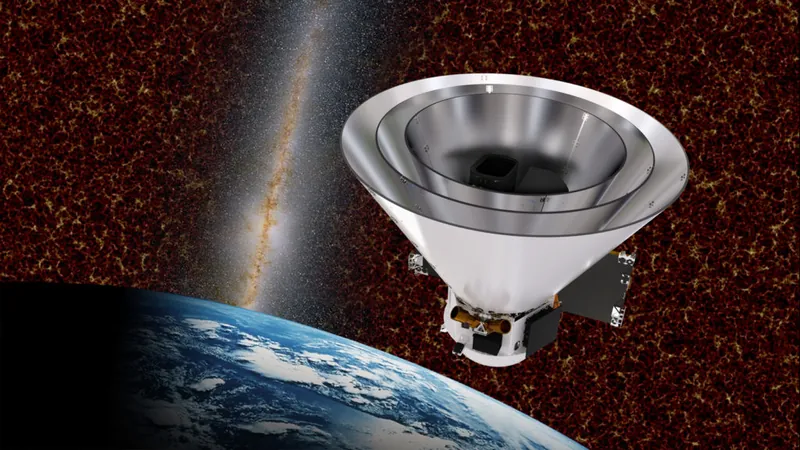
Out-of-This-World Space Missions to Keep an Eye on in 2025!
2024-12-31
Author: Daniel
As we wrap up 2024, it’s undeniable that this year marked an exhilarating phase in space exploration. With significant achievements from NASA, SpaceX, and the Chinese space program, our quest to uncover the mysteries of the universe is far from over. Buckle up, because 2025 is poised to be an even more groundbreaking year, filled with incredible missions that promise to push the boundaries of human knowledge and ambition.
Witness the Lunar Renaissance with CLPS
NASA's Commercial Lunar Payload Services (CLPS) initiative is set to revolutionize how we explore the Moon. Building on the success of Intuitive Machines’ Odysseus lander, which landed in February 2024, several missions are lined up for 2025. Companies like Astrobotic, Intuitive Machines, and Firefly Aerospace will deliver crucial scientific payloads to various lunar locations. Expect experiments that delve into lunar geology, assess new technologies for future human missions, and extensively analyze the Moon’s environment – all paving the way for sustainable lunar exploration.
Reach for the Stars with SPHEREx
Launching in February 2025, NASA’s SPHEREx (Spectro-Photometer for the History of the Universe) mission will survey the cosmos like never before. Utilizing advanced near-infrared technology, SPHEREx is set to unveil the hidden wonders of over 450 million galaxies and 100 million stars within our Milky Way. This spectacular survey aims to unravel critical mysteries regarding the origins of galaxies and the distribution of water and organic molecules in star-forming regions, providing essential bits of the cosmic puzzle.
Space Rider: The Future of Earth Orbit Research
The European Space Agency (ESA) is gearing up for an uncrewed orbital test flight of the Space Rider spaceplane in late 2025. This reusable spacecraft will conduct vital scientific experiments in low Earth orbit, focusing on microgravity research that could reshape our understanding of biology, materials science, and advanced technologies. The results from this mission will be pivotal in preparing for future interplanetary missions.
Japan’s Ambitious M2/Resilience Mission
Scheduled for January 2025, Japan's M2/Resilience mission will deliver a lander and micro-rover to the lunar surface to analyze geological composition and test water-splitting technology. By generating oxygen and hydrogen from lunar ice, this mission will lay the groundwork for long-term human presence on the Moon. The innovative navigation systems and autonomous rover operations being tested here could one day facilitate similar explorations on Mars.
China’s Bold Tianwen-2 Mission
In May 2025, China plans to launch its Tianwen-2 mission, aiming to collect samples from the near-Earth asteroid 469219 Kamo`oalewa and investigate a comet. This mission is set to significantly enhance our understanding of the solar system's formation, utilizing cutting-edge techniques to gather samples from Kamo`oalewa, which might even be a fragment of the Moon!
Thrilling Deep-Space Flybys on the Horizon
Aside from these significant exploratory missions, numerous space agencies will be executing thrilling flyby operations in 2025. The ESA and JAXA’s BepiColombo mission will perform a key flyby of Mercury, paving the way for its entry into orbit by late 2026. Meanwhile, NASA’s Europa Clipper will conduct a critical Mars flyby in March 2025 to align its trajectory toward Jupiter's moon Europa, where secrets of extraterrestrial life could await.
Additionally, the ambitious Lucy mission will provide insights into the ancient rocks of the Jupiter Trojan asteroids during its flyby of 52246 Donaldjohanson. Such missions not only maximize fuel efficiency through gravity assists but also enhance our understanding of planetary development.
The Year Ahead: A Journey into the Unknown
With the upcoming missions and continuing advancements, 2025 promises to be an exhilarating chapter in humanity’s quest for knowledge about the cosmos. From lunar explorations to asteroid investigations and spectacular flybys, these missions will redefine our understanding of space and inspire generations to continue looking toward the stars. So the stage is set—don’t miss what will unfold in the coming months!




 Brasil (PT)
Brasil (PT)
 Canada (EN)
Canada (EN)
 Chile (ES)
Chile (ES)
 Česko (CS)
Česko (CS)
 대한민국 (KO)
대한민국 (KO)
 España (ES)
España (ES)
 France (FR)
France (FR)
 Hong Kong (EN)
Hong Kong (EN)
 Italia (IT)
Italia (IT)
 日本 (JA)
日本 (JA)
 Magyarország (HU)
Magyarország (HU)
 Norge (NO)
Norge (NO)
 Polska (PL)
Polska (PL)
 Schweiz (DE)
Schweiz (DE)
 Singapore (EN)
Singapore (EN)
 Sverige (SV)
Sverige (SV)
 Suomi (FI)
Suomi (FI)
 Türkiye (TR)
Türkiye (TR)
 الإمارات العربية المتحدة (AR)
الإمارات العربية المتحدة (AR)